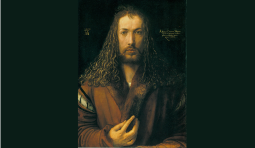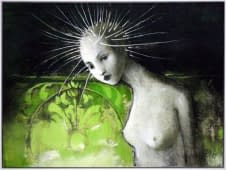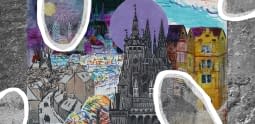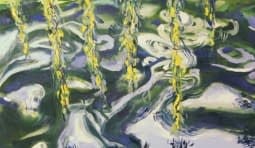Artists Influence Artists Part 3: On to Munich and Switzerland
If you would like to return to the beginning of the journey, you will find the first part here, which begins with the indirect influence of Spanish artists and ends with the direct impact of two New York artists. The second part continues the latter topic and introduces two pairs of artists who influenced each other artistically and painterly in Paris and Berlin.
In the final part of the blog series, the second-last destination starts in Munich.
Elisabeth Epstein and Robert Delaunay
The two relocations of the painter Elisabeth Iwanowna Epstein (1879-1956) to Munich in 1896 and to Paris in 1906 were formative moments in the artist's life. In Munich she met Anton Ažbe, Wassily Kandinsky (1866-1944) and Alexej von Jawlensky (1864-1941), and in Paris, in the artists' settlement in Montparnasse, the paintress Sonia Delaunay-Terk (1885-1979), with whom she lived for some time.
Especially with Kandinsky and the couple (Sonia and Robert) Delaunay she developed a deep friendship. Friendships that had a strong impact on Epstein's artistic career.
When Epstein took part in the first Blaue Reiter exhibition in Munich in 1911, she acted as a crucial link between her artist friend's husband, Robert Delaunay, and the founding members of the Blaue Reiter artists' association, Kandinsky and Franz Marc (1880-1916), who, through Epstein's mediation, included him in their exhibition. Robert Delaunay successfully sold three of his works that day, more than any other artist represented there.
Conversely, the Delaunay couple also had a significant influence on Epstein's artistic development. In particular, the artist's later works are influenced by the orphistic painting style of her artist friends. All three went from an initial colour-intensive painting style to a later Cubist, abstract and Orphist art movement. Epstein's late works were mainly still lifes, as the painting «Still Life with Plant» (1949) impressively demonstrates.
Jean Tinguely and Bernhard Luginbühl
The Swiss artist Jean Tinguely (1925-1991) was also drawn to Paris in 1952 and three years later to the same artists' settlement «Impasse Ronsin» in the Montparnasse district as Epstein had been in 1906. Max Ernst (1891-1976), Eva Aeppli (1925-2015), Niki de Saint Phalle (1930-2002) and Constantin Brâncusi (1876-1957), among others, lived and worked in this Parisian artists' quarter, which existed from 1886 to 1971. Here, the studios were filled with art and life.
«I have always tried to work together with other artists, if only to get beyond myself. Because sometimes I feel like I’m trapped inside myself, and forced to be myself, I feel like one condemned. I cannot do otherwise than what I do.
(Quotation Jean Tinguely, Source: Museum Tinguely Basel)
In 1955, Jean Tinguely met the French artist Yves Klein (1928-1962), with whom he worked on a collaborative art project that same year and also exhibited it. Like Warhol and Basquiat, each pursued his expertise. Tinguely was responsible for the mechanical device, Klein painted it.
Tinguely, on the other hand, had a more intensive collaboration and friendship with Bernard Luginbühl (1929-2011), whom he met in 1957. They exhibited together in Bern, Lucerne, Eindhoven and Frankfurt, among other places, and worked on joint art projects such as «Crocrodome» (1977) and «Le Cyclop» (1970-1988). Luginbühl filmed Tinguely while he was working, and Tinguely wrote letters to his friend. Tinguely produced the so-called «picture letters» or «picture collages» for many of his friends, work colleagues and family. He combined text with pictures and sent the work as a letter to his acquaintances. Hundreds of illustrated messages, which he produced in his studio, in the restaurant, in lodgings and from the road, were created on the spot and out of the moment. One of these illustrated letters, addressed to curator Fritz Billeter, can be admired on art24.
Source reference and links for further information:
- Elisabeth Epstein: Epstein, Elisabeth (1879-1956) | Galerie Orlando GmbH (orlando-gmbh.ch)
- Impasse Ronsin: Impasse Ronsin | Museum Tinguely Basel
- Tinguely und Luginbühl: LUGINBÜHL total | Museum Tinguely Basel and BERNHARD LUGINBÜHL STIFTUNG - Biografie Bernhard Luginbühl (luginbuehlstiftung.ch)
The first journey and exploration of past artist relationships comes to an end (for now) with this third part of the blog. But the art world continues to live and grow. It will continue to be inspired by the past, the present and the future.
The following blog post «Places of longing - the history of artists colonies» by Martina Kral provides insights into the formation of artist communities or artist colonies.
Glossary
Orphism: Orphism developed as an art style out of cubism in the early 20th century. It follows an abstract non-objective colorful or color-intensive design.







